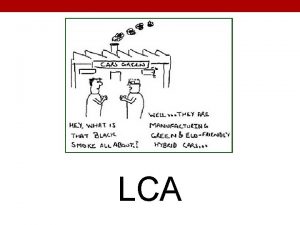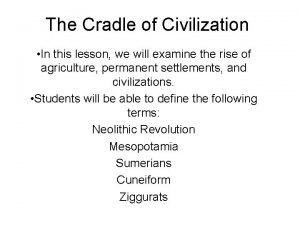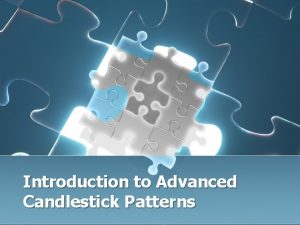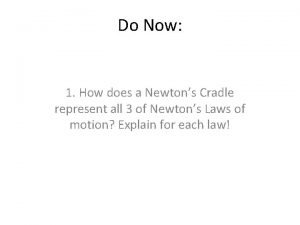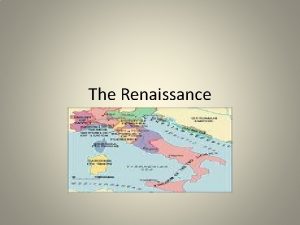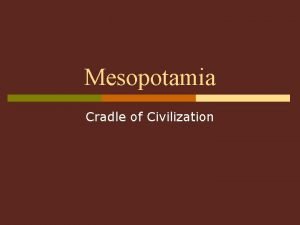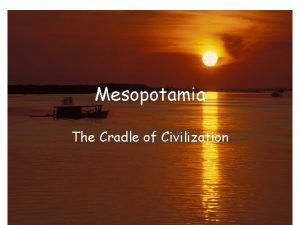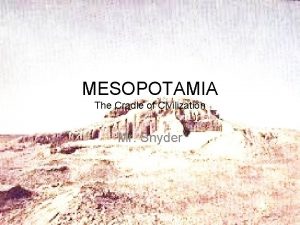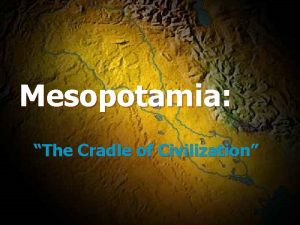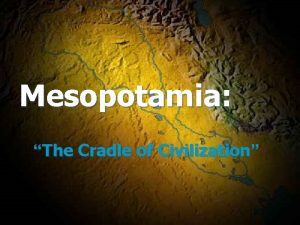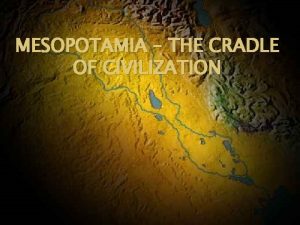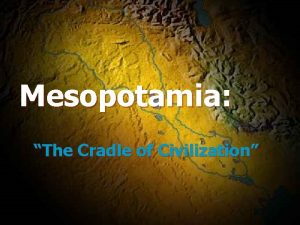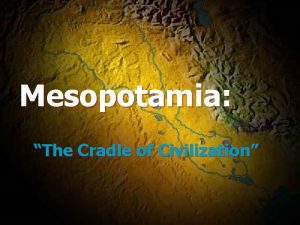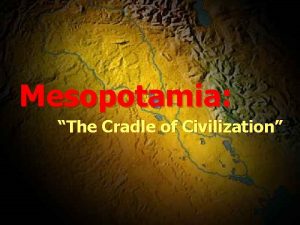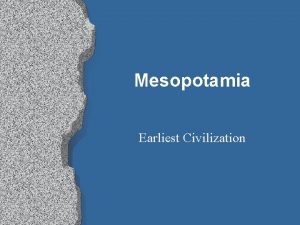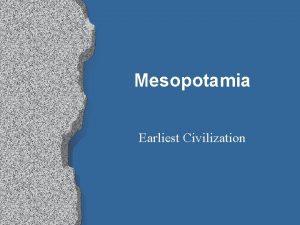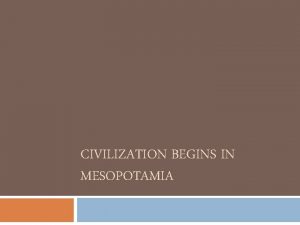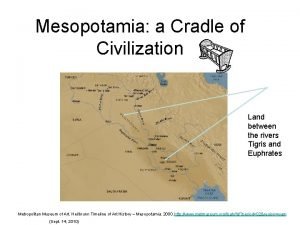Mesopotamia The Cradle of Civilization The word Mesopotamia

















- Slides: 17

Mesopotamia! The Cradle of Civilization

The word Mesopotamia means “Land between Rivers”. …Which 2 rivers was Mesopotamia nestled between?

Answer: • Mesopotamia was nestled between the Euphrates and Tigris Rivers.

Which modern-day country do we find in the territory where Mesopotamia once existed? • Answer : Iraq

The Fertile Valley: • What natural geographical traits made Mesopotamia quite fertile, despite it being located in a part of the world surrounded by desert, with little rainfall?

It was located in an area known as the Fertile Crescent. • This crescent is fertile mainly because it is located between the Mediterranean Sea and the Persian Gulf. There are large rivers as well, running through it, such as the Tigris, Euphrates and Nile Rivers, which make the surrounding land more fertile, because the water from the rivers enables the growth of plants and supports wild-life.

The Delta leading to the Persian Gulf • The Delta that leads to the Persian Gulf was also an important Geographical Feature of Mesopotamia…Why?

Answer: • At the mouth of the Gulf, the 2 rivers split into smaller streams that created marshly wetlands, which we call a Delta. • The Delta lent many different benefits to the Mesopotamians. For example Ø It attracted and supported wildlife, ideal for fishing and hunting. Ø The marshy swamps provided reeds, a kind of plant that made excellent materials for building

ADAPTING TO THE ENVIRONMENT • We learned that the environment where Mesopotamia existed did have some problems. • The Mesopotamians learned to irrigate (water) their crops with the water from the rivers and streams. • They also built dikes, which directed the flow of water. • They created a complex system of irrigations ditches and canals. • This all contributed to their success, especially with regard to growing crops and building cities.

However… • However, after a few hundred years, a problem arose, to do with the composition of the soil…what was this problem?

Answer: • The desert soil contained a lot of salt. • The irrigation caused this salt to rise to the surface of the soil. • The extra salt poisoned the plants. • The more the people irrigated the crops, the saltier the soil became. • Eventually, the soil could no longer produce crops, and the people of these cities began to die out, or move to other areas.

How did goods get traded to neighbouring territories? • The rivers and canals made trading ideal, and soon, these transformed Mesopotamia into the Centre of Trade in the region. • Caravans on trade-routes also carried goods and people.

CONTACT • Mesopotamia thrived for many reasons. These reasons include: ØFarming ØCreating goods, such as tools, clothing and textiles, etc. ØSelling their services to others in the community, and buying services as well.

Goods and Services: What were some offered? • Leatherwork • Carpentry • Weaving • Metalwork • These goods were traded in exchange for other goods and services, not only within Mesopotamia, but with surrounding territories.

What resources did they import? • Building stone from Africa • Copper from Cyprus • Gold from Egypt • Cedar from Lebanon

Which goods were sold or exported from Mesopotamia? • Wool • Cloth • Jewellery • Oil • Grains

Other than goods, services and resources, what did Trade bring? • Trade routes connected people, and cultures • Therefore, people learned each other’s languages, customs and religions. • Inventions and innovations were also exchanged. People often adapted the ways of others, if they were more effective or efficient, or if they made their lives easier in any way. • New ways of making pottery, new tools, and new farming methods quickly spread and were adapted. • This “Trade of ideas” helped the Mesopotamian society flourish.
 Mesopotamia the cradle of civilization worksheet answers
Mesopotamia the cradle of civilization worksheet answers Cradle to cradle design
Cradle to cradle design Cradle to grave cradle to gate
Cradle to grave cradle to gate Cradle to cradle boek
Cradle to cradle boek Cradle to grave housing report
Cradle to grave housing report The cradle of civilization
The cradle of civilization Introduction of mesopotamian civilization
Introduction of mesopotamian civilization Golden cradle kindergarten
Golden cradle kindergarten Cradle pattern trading
Cradle pattern trading Cardiac table comfort device
Cardiac table comfort device Okonkwo's attitude as he prepares to return to the clan is
Okonkwo's attitude as he prepares to return to the clan is Cradle of liberty merit badge college
Cradle of liberty merit badge college Pivoted cradle balancing machine
Pivoted cradle balancing machine Newton's cradle
Newton's cradle Leg cradle to lateral lunge
Leg cradle to lateral lunge Cradle of the renaissance
Cradle of the renaissance Newton's cradle
Newton's cradle Newton's cradle
Newton's cradle


